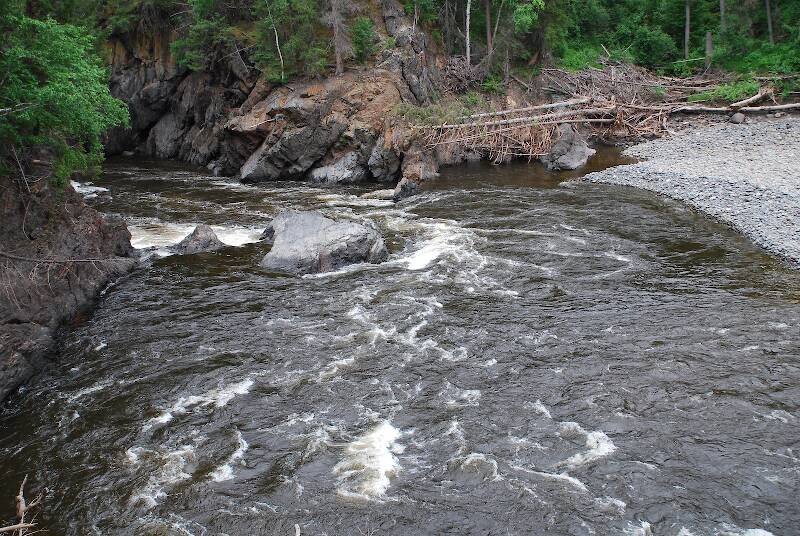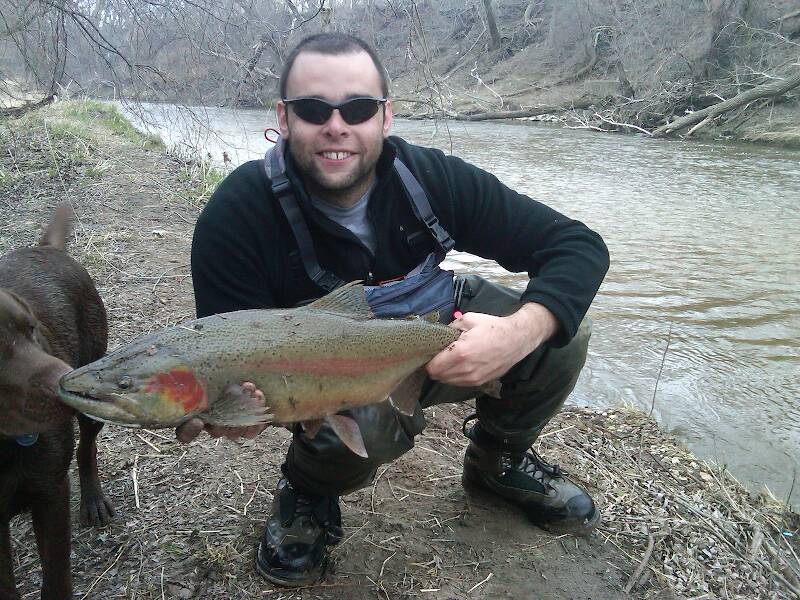
Salmonflies
Pteronarcys californica
The giant Salmonflies of the Western mountains are legendary for their proclivity to elicit consistent dry-fly action and ferocious strikes.
Featured on the forum

It's only barely visible in one of my pictures, but I confirmed under the microscope that this one has a prosternal horn and the antennae are mid-way between the eyes and front of the head capsule.
I'm calling this one Pycnopsyche, but it's a bit perplexing. It seems to key definitively to at least Couplet 8 of the Key to Genera of Limnephilidae Larvae. That narrows it down to three genera, and the case seems wrong for the other two. The case looks right for Pycnopsyche, and it fits one of the key characteristics: "Abdominal sternum II without chloride epithelium and abdominal segment IX with only single seta on each side of dorsal sclerite." However, the characteristic "metanotal sa1 sclerites not fused, although often contiguous" does not seem to fit well. Those sclerites sure look fused to me, although I can make out a thin groove in the touching halves in the anterior half under the microscope. Perhaps this is a regional variation.
The only species of Pycnopsyche documented in Washington state is Pycnopsyche guttifera, and the colors and markings around the head of this specimen seem to match very well a specimen of that species from Massachusetts on Bugguide. So I am placing it in that species for now.
Whatever species this is, I photographed another specimen of seemingly the same species from the same spot a couple months later.
I'm calling this one Pycnopsyche, but it's a bit perplexing. It seems to key definitively to at least Couplet 8 of the Key to Genera of Limnephilidae Larvae. That narrows it down to three genera, and the case seems wrong for the other two. The case looks right for Pycnopsyche, and it fits one of the key characteristics: "Abdominal sternum II without chloride epithelium and abdominal segment IX with only single seta on each side of dorsal sclerite." However, the characteristic "metanotal sa1 sclerites not fused, although often contiguous" does not seem to fit well. Those sclerites sure look fused to me, although I can make out a thin groove in the touching halves in the anterior half under the microscope. Perhaps this is a regional variation.
The only species of Pycnopsyche documented in Washington state is Pycnopsyche guttifera, and the colors and markings around the head of this specimen seem to match very well a specimen of that species from Massachusetts on Bugguide. So I am placing it in that species for now.
Whatever species this is, I photographed another specimen of seemingly the same species from the same spot a couple months later.

Troutnut is a project started in 2003 by salmonid ecologist Jason "Troutnut" Neuswanger to help anglers and
fly tyers unabashedly embrace the entomological side of the sport. Learn more about Troutnut or
support the project for an enhanced experience here.
Pnwjeep4x4
Posts: 1
Posts: 1
Pnwjeep4x4 on Apr 9, 2016April 9th, 2016, 5:39 pm EDT
I've found a couple kits for $150 which seem like a good deal. I live in Washington and am looking to get trout. I understand the weight/length relationship, I just want to know whether kits would be a good purchase. I don't want to spend more than $200. Thanks in advanced!
Ospika1 on Apr 18, 2016April 18th, 2016, 10:47 am EDT
Most of the kits that are available in that price range are a decent way to start. Just make sure that all off the pieces match for instance if the kit has a 6 weight rod, you want a 6 weight line, and 6 weight reel to match. Even when you buy the pieces separately you want to match all of the parts. The kit should do that for you without any guessing.
Fly Reel, Fly Boxes, Monthly Fly Packs
http://ospikagear.com
http://ospikagear.com
CaseyP on Apr 19, 2016April 19th, 2016, 11:01 am EDT
kits are a wonderful place to start. i've heard good things about Courtland and Ross. the kits i've seen lately even have the leader already on the line. if you can, find out what size the leader is (5x, 4x, etc.) and get a spool of tippet to match. that way when you change flies for the 95th time and the leader is a bit short, you can add some tippet to it and keep the cast right and the fish unaware.
the hard part is getting out of the store without buying everything else they'd like to sell you.
here is a very basic list:
Kit: rod, reel, backing, flyline with leader attached
an extra leader
nippers (the knots you'll find at Groggs' Animated Knots online)
forceps/hemostat
half a dozen flies for the water you'll be fishing
now i expect and hope that every single Troutnut will weigh in with more and better suggestions of What Every Beginner Absolutely Needs to Have...;-)
the hard part is getting out of the store without buying everything else they'd like to sell you.
here is a very basic list:
Kit: rod, reel, backing, flyline with leader attached
an extra leader
nippers (the knots you'll find at Groggs' Animated Knots online)
forceps/hemostat
half a dozen flies for the water you'll be fishing
now i expect and hope that every single Troutnut will weigh in with more and better suggestions of What Every Beginner Absolutely Needs to Have...;-)
"You can observe a lot by watching." Yogi Berra
Kschaefer3 on Apr 19, 2016April 19th, 2016, 1:32 pm EDT
I bought my dad an RLS+ combo from Cabelas for Father's Day last year. I was very impressed when I cast it in the parking lot and the few times I've used it while fishing with him. It is a very smooth rod actually with a nice moderate action. I doubt you can find a better combo for $140. That's just my opinion though.
MikePM
Posts: 1
Posts: 1
MikePM on Aug 4, 2016August 4th, 2016, 11:58 am EDT
I know its a little late to reply, but I bought the Cabella's RLS 5wt package for my son, and the RLS reel with a Limit Creek 9' rod and Orvis Hydros HD Power Taper line for myself. The RLS reel is great and worth the price of the combo by itself. I didn't find another machined aluminum reel for under $150 that I thought was as good.
The Cabella's line was the weak link in the combo and was turning my son's hand yellow. The RLS rod was a little stiff, but pretty good for the price. The upgrade to the Limit Creek rod made a difference and I think was the reason we caught more on it.
My suggestion would be to go with the combo, and upgrade the line right away. If you really enjoy fly fishing, then get a better rod down the road.
The Cabella's line was the weak link in the combo and was turning my son's hand yellow. The RLS rod was a little stiff, but pretty good for the price. The upgrade to the Limit Creek rod made a difference and I think was the reason we caught more on it.
My suggestion would be to go with the combo, and upgrade the line right away. If you really enjoy fly fishing, then get a better rod down the road.
Kilocharlie on Feb 10, 2017February 10th, 2017, 11:45 am EST
I live in Southern California, so take what I say with a grain of salt.
I hate to show up the new guy and oppose what others have posted, but I think a kit is a terrible choice. It appears to me that most kits are put together by marketers or bean counters, not fly fishermen. There may be exceptions out there. I have not checked them in several years.
You are in Washington, where most fly fishing is done with a 9-weight rod. With salmon and steelhead in the mix, you need the extra power to land the fish. I've never seen a beginner kit with a 9-weight rod, they are mostly 4- and 5-weights. If you are planning on fishing only tiny creeks, you could go as large as 6-weight, but I would not.
The reason is due to the recent profusion of lines, and the advantages they offer. I can now present a tiny fly in still water as delicately with a 9-weight as I can with a 4-weight, and I can do a WHOLE LOT MORE with that 9-weight rod. Like fishing for steelhead, salmon, largemouth and smallmouth bass, pike, muskellunge, tuna, striped bass, bonefish, and, yes golden trout in the high Sierra lakes, even in the wind.
Rio started making many line designs for specific situations, and many with interchangeable tips. Sink tips with 2-1/2, 5, 10, and 15 feet of sinking line. Sink rates from 1 inch per second to upwards of 9 inches per second.Super short, heavy tapers, super long tapers, special tapers with matching bellies for every species in the temperature range you'll find them in. Lead core substitutes called T-8, T-11, T-14, T-18 that are more flexible than leadcore and offer different sink rates.
Other manufacturers have joined in the fun, so now there is a HUGE choice of lines.
I can use a 7-weight short Skagit line on my 9-foot, 9-weight rod with a 4-weight long-taper looped on out in front of it (the weights of the two added together works for a 9-weight, about 425 grains) to throw size 20 black gnats to brookies and golden trout in winds that would have prevented me from fly casting with a 4-weight rod, and present delicately as a 4-weight in no wind.
As this concept spreads, the smaller rods may become obsolete. I no longer have nor need rods under the 7/8/9 range, although I did keep a 7/8 slow action rod to convert into a light Spey by adding 54 inches to the butt (I used a graphite golf club that bent about right) and making a new handle, reel seat, and ferrule. I can see keeping a 3-weight if I had and wanted to fish for 8-inch trout in a tiny, local creek, but my fishing time is too important to me for that.
I've been setting beginning customers up with 9- to 12-weight rods for a decade now. They love to tell me about catching 4-1/2 pound corvina in the surf, largemouths over 9 pounds, striped bass, bonito, calico bass, yellowtail, rooster fish, and also trout in the local streams.
We're using 12/13-weight sized reels just in case the extra backing is needed with really big fish. A few have been glad they did get a larger reel - one caught a 24 pound yellowtail, another has wrestled several striped bass from 12 to 31 pounds and a 28 pound king salmon. My best on the fly rod so far was a 12 lbs ling cod in the surf. YES, a ling cod in about 2 feet of water. The big reel will nicely balance your Spey rod, should you elect to go that route in the future. Most guys are getting at least one extra spool for a second line, usually one floating and one sink tip. I carry a 3rd if I'm going to a deep, fast river spooled with Rio's T-14 and lots of backing for weighted flies and deep work.
Advanced fly fishermen have gotten in to Spey rods, casting, and methods, still others are finding Switch rods are about right for their waters. Don't worry about Spey nor Switch rods yet. Just learn basic fly casting first. A lot of us fished 40+ years without needing to move up to Switch or Spey rods. They are for BIG water, though you have plenty of that in your state, so you may end up with either or both. Those are more expensive rods/reels/lines, and will prove a headache until you are ready for, and need such a rig.
Take lessons from an FFF certified instructor when you are ready to improve. Go on a trip with a local fly fishing guide. Your learning curve will be much happier.
Good luck!
I hate to show up the new guy and oppose what others have posted, but I think a kit is a terrible choice. It appears to me that most kits are put together by marketers or bean counters, not fly fishermen. There may be exceptions out there. I have not checked them in several years.
You are in Washington, where most fly fishing is done with a 9-weight rod. With salmon and steelhead in the mix, you need the extra power to land the fish. I've never seen a beginner kit with a 9-weight rod, they are mostly 4- and 5-weights. If you are planning on fishing only tiny creeks, you could go as large as 6-weight, but I would not.
The reason is due to the recent profusion of lines, and the advantages they offer. I can now present a tiny fly in still water as delicately with a 9-weight as I can with a 4-weight, and I can do a WHOLE LOT MORE with that 9-weight rod. Like fishing for steelhead, salmon, largemouth and smallmouth bass, pike, muskellunge, tuna, striped bass, bonefish, and, yes golden trout in the high Sierra lakes, even in the wind.
Rio started making many line designs for specific situations, and many with interchangeable tips. Sink tips with 2-1/2, 5, 10, and 15 feet of sinking line. Sink rates from 1 inch per second to upwards of 9 inches per second.Super short, heavy tapers, super long tapers, special tapers with matching bellies for every species in the temperature range you'll find them in. Lead core substitutes called T-8, T-11, T-14, T-18 that are more flexible than leadcore and offer different sink rates.
Other manufacturers have joined in the fun, so now there is a HUGE choice of lines.
I can use a 7-weight short Skagit line on my 9-foot, 9-weight rod with a 4-weight long-taper looped on out in front of it (the weights of the two added together works for a 9-weight, about 425 grains) to throw size 20 black gnats to brookies and golden trout in winds that would have prevented me from fly casting with a 4-weight rod, and present delicately as a 4-weight in no wind.
As this concept spreads, the smaller rods may become obsolete. I no longer have nor need rods under the 7/8/9 range, although I did keep a 7/8 slow action rod to convert into a light Spey by adding 54 inches to the butt (I used a graphite golf club that bent about right) and making a new handle, reel seat, and ferrule. I can see keeping a 3-weight if I had and wanted to fish for 8-inch trout in a tiny, local creek, but my fishing time is too important to me for that.
I've been setting beginning customers up with 9- to 12-weight rods for a decade now. They love to tell me about catching 4-1/2 pound corvina in the surf, largemouths over 9 pounds, striped bass, bonito, calico bass, yellowtail, rooster fish, and also trout in the local streams.
We're using 12/13-weight sized reels just in case the extra backing is needed with really big fish. A few have been glad they did get a larger reel - one caught a 24 pound yellowtail, another has wrestled several striped bass from 12 to 31 pounds and a 28 pound king salmon. My best on the fly rod so far was a 12 lbs ling cod in the surf. YES, a ling cod in about 2 feet of water. The big reel will nicely balance your Spey rod, should you elect to go that route in the future. Most guys are getting at least one extra spool for a second line, usually one floating and one sink tip. I carry a 3rd if I'm going to a deep, fast river spooled with Rio's T-14 and lots of backing for weighted flies and deep work.
Advanced fly fishermen have gotten in to Spey rods, casting, and methods, still others are finding Switch rods are about right for their waters. Don't worry about Spey nor Switch rods yet. Just learn basic fly casting first. A lot of us fished 40+ years without needing to move up to Switch or Spey rods. They are for BIG water, though you have plenty of that in your state, so you may end up with either or both. Those are more expensive rods/reels/lines, and will prove a headache until you are ready for, and need such a rig.
Take lessons from an FFF certified instructor when you are ready to improve. Go on a trip with a local fly fishing guide. Your learning curve will be much happier.
Good luck!
Sharpen your hook. Check it with a 20X magnifier. Always use a new tippet.
Wbranch on Feb 11, 2017February 11th, 2017, 2:47 am EST
Kilo wrote;
Well that surely didn't stop you from putting in your biased opinions. Maybe you can afford to select individual items to put together the best balanced fly rod, reel, line, and backing system in all of southern CA but many novice fly anglers either don't have that much disposable income or are unsure if they want to pull the trigger on a $1000 - $1500 outfit.
This sir will never happen. Many of the major rod companies are now touting switch and spey rods in the very light line series. I have seen a number of 3, 4, and 5 weight rods being used for everything from trout on eastern and western rivers to steelhead on Lake Erie streams and rivers. I personally use a 11' #6 switch rod on the PA, OH, and NY steelhead waters to much success with virtually no fatigue.
I hate to show up the new guy and oppose what others have posted, but I think a kit is a terrible choice.
Well that surely didn't stop you from putting in your biased opinions. Maybe you can afford to select individual items to put together the best balanced fly rod, reel, line, and backing system in all of southern CA but many novice fly anglers either don't have that much disposable income or are unsure if they want to pull the trigger on a $1000 - $1500 outfit.
As this concept spreads, the smaller rods may become obsolete. I no longer have nor need rods under the 7/8/9 range
This sir will never happen. Many of the major rod companies are now touting switch and spey rods in the very light line series. I have seen a number of 3, 4, and 5 weight rods being used for everything from trout on eastern and western rivers to steelhead on Lake Erie streams and rivers. I personally use a 11' #6 switch rod on the PA, OH, and NY steelhead waters to much success with virtually no fatigue.
Catskill fly fisher for fifty-five years.
RanchMT on Apr 12, 2017April 12th, 2017, 6:45 am EDT
I too have used the Cabela's RLS+ combo and was pleasantly surprised by the quality and price. You are looking for something below $200 and I think that the only way you are going to get a decent set up for that price is to buy a combo set. Buying each piece individually is going to be too expensive. You can always buy a combo and then change out the line and leader to what works best for you. The combos are a great place to start and make sure that you enjoy fly fishing. Hopefully that helps a little bit.
Quick Reply
Related Discussions
Topic
Replies
Last Reply
6
Nov 12, 2012
by Brookyman
by Brookyman
1
Sep 7, 2015
by PaulRoberts
by PaulRoberts






